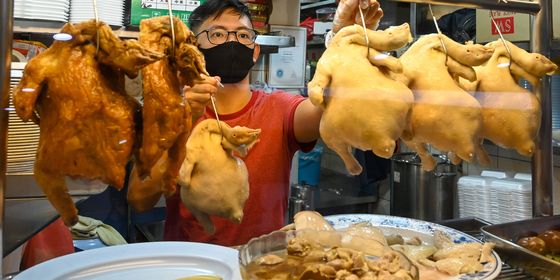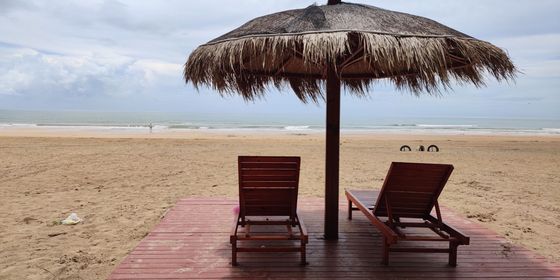A rambling search reveals a grueling history behind the local beans
“I heard that there is a town somewhere in Hainan where the villagers love to drink coffee,” I told my perhaps overly enthusiastic cab driver.
“That’s unlikely,” he said, confused. “I’ve never heard of such a place. We Hainanese drink tea.”
Despite having been to several cities on the island, thus far none of the locals seemed to have the slightest clue what I was talking about. Admittedly, the information that spurred this trip came from a relatively unreliable source: a year previous, a traveler who had biked around Hainan mentioned going through a town where the population was unusually addicted to coffee, sold at roadside stalls. Although China’s coffee market is booming, it has largely been an urban obsession, and its wholesale adoption in a rural area would be a rare sight indeed.
Many imagine Hainan as a tropical island paradise, but the reality is a province fed on real estate. New apartment buildings rise up along old narrow roads, cropping off the sky, and concrete high-rise communities inch ever-closer to the coast. Most apartment buyers are from Dongbei, China’s coldest provinces in the northeast. They are attracted by Hainan’s omnipresent real estate advertisements in their home provinces and a romantic ideal of the tropical seaside life. Hainan people, on the other hand, call them “migrant birds” and are amused by their poetic longing for the sea. It’s far from ideal; the salty sea spray and forceful wind causes unrelenting rust and electronic appliances need to be replaced quite often. There are also about 20 typhoons each year. Regardless, the real estate business is still booming and has forever changed the island’s look.
There are only two counties in Hainan where coffee plantations are concentrated: Fushan (福山) and Xinglong (兴隆). Fushan is only half an hour’s drive away from Haikou (海口), the capital of the province—where people assured me that the plantation had shrunk to almost nothing, and that “there is nothing there”. When attempting to get information about Xinglong from the locals, they invariably twisted their faces in surprise and said: “That’s really remote! Why the hell are you going?”
Perhaps the word obscure is more apt than remote. The town is located on the island’s eastern coastal highway, making it a must-pass for bikers but not very convenient for other travelers. Indeed, it’s strange how obscure it is for the locals. Despite its relative anonymity, the area has played host to a number of historic characters. All the coffee produced there, which started in the 1950s, has received visits from every chairman of PRC with the singular exception of Mao Zedong, who each paid tribute to the “Overseas Chinese Farm”— run by ethnically Chinese immigrants who returned to China.

The people of Xinglong have a long history with coffee, and it remains an important part of the local cuisine and culture
After an hour-long bus ride from the train station, the first thing travelers see is a stone standing in a conspicuous corner with former Premier Zhou Enlai’s handwriting reading: “Xinglong coffee is indeed good.”
That auspicious statement, however, was somewhat marred by what came next: the reason no one knew about Xinglong. It is not a tourist-friendly place. The small town has no traffic lights or public facilities. Everyone gets around on electric motorcycles. The main street only has two lanes, and you have to risk your life to cross it in a whirl of motorcycles, tricycles, and small trucks. Street stalls sell cigarettes, betel nuts, coconuts, and rice noodles. Not a single sign said coffee. Perhaps, it crossed my mind, the business has died out, just as in Fushan. The only interesting drink I could find was a sweet and sour vitamin drink called “Obacow”, a play on words of US President Barack Obama’s name; in the Chinese translation, Obama’s name ends with ma, horse.
For a small repose, I sought noodles in a shop with four black and greasy walls. Hainan local snacks are not very diverse—most are rice noodles in different sauces. The jaunt seemed all but hopeless and the famously beautiful beaches of Sanya down south seemed a much better option, despite the winter chill.
But, then, I smelled the unmistakable miasma of coffee wafting my way. I was almost startled, and asked the shop owner, “Does anyone sell coffee around here?” He said, “We do. Three kuai a cup.”

Rice noodles with coffee
That’s why not a single sign said coffee—just like there was no need to say they sell rice noodles. The coffee, available at every restaurant, is made in a crude manner; ground coffee powder is put into a filter bag made of gauze (sometimes even a towel), boiled in an iron pot on an induction cooker, and then poured. Only two kinds of coffee are available here: coffee and coffee with milk, which the locals call “咖啡奶”. Most restaurants have plastic chairs outside by the road, and the locals can have coffee with rice noodles, fried dough, steamed buns, peanuts, and sunflower seeds.
But a small question remained: were there any “overseas Chinese” left living in this town? I wondered. Sixty years had passed since they first came here. They would be very old. Wondering where the farm was, I searched the map and was quite surprised to find it was just 100 meters away. The destination, it turned out, did not look like what one might think of as a farm—just an old, three-storey office building without any demarcating features. I knocked at the first office and a young man came out.
“Yes, we are the farm,” he said. The building turned out to be where the farm staff worked. When asked if there were still immigrants in town, the young man said “of course”, as if I’d asked a very stupid question. He pointed to a woman in a bright yellow sweater next door. “She is an immigrant from Vietnam.”
The woman he pointed to was not old at all. She looked to be in her 30s, with big, gentle eyes and full lips, often characteristic of Southeast Asian features. Her surname was Liang.

Now in his 80s, this Thai-Chinese man returned to China in the 1950s and still has coffee everyday at Vasily
“I came back to China in 1979 from Vietnam,” she told me. “But if you want to, you can go to the Indonesian restaurant my father-in-law owns close to the gas station. My father-in-law should be there right now. He came here in the early 1960s, and he knows a lot more than I do.”
The restaurant looked exceptionally nice for this town. It smelled of freshly made coconut milk and curry, and the gate was decorated with a mini-sized Candi bentar—an example of Balinese architecture. Liang’s father-in-law, a 70-year-old man surnamed Du, still looked very handsome and in good health, and when he spoke he didn’t have the distinct Hainanese accent. He told me that his accent is called the “peanut candy accent”, a combination of Hainan and Indonesian accents, named after the peanut candy from Indonesia. In his unhurried, dignified voice, he told the story of Xinglong.
The tale goes back to 1948 when Malaya was still under the rule of the Commonwealth authorities and ethnic Chinese made up the majority of the Malayan Communist Party. Du called it a “revolution export” of the Communist camp. In 1948, the party was declared illegal after the well-known Malayan Emergency, and party members were arrested in large numbers. Many Malayan Chinese fled back to China, and after the PRC was founded in 1949, the Chinese government relocated 765 of them to the farms of Xinglong. Even today, you can still hear elderly people in Xinglong habitually say “Malaya” instead of “Malaysia”.
In 1959, the population of Xinglong had more significant growth with the Indonesian government revoking the trading rights of the ethnic Chinese in rural areas. Over 100,000 Indonesian Chinese left for China on ships sent by the Chinese government, and 2,035 of them were relocated to Xinglong, including Du. “In Indonesia, we grew up in Chinese communities and could speak both Chinese and Bahasa. We had access to the Chinese press like People’s Pictorial and People’s Daily, and the message that China was our motherland was reinforced in our education,” says Du. “So we gave up our Indonesian nationality and became Chinese.”
The peak of the farm’s expansion came in 1979 when 5,720 Vietnamese Chinese immigrated there after the Sino-Vietnamese War broke out.
However, not all of them immigrated due to political reasons. In the end, over 12,000 immigrants from 21 countries and regions were relocated to Xinglong. Some of them came back out of patriotism. The founding of the PRC opened up a new era of hope and boiling nationalism. Immigrants sold their estates and left their families in response to China’s call that the motherland needed their contributions. With the world on guard against communism, they had to go through meticulous searches before boarding ships to China, and anything metal or of value could not go with them. Nevertheless, they succeeded in smuggling seeds for rubber, white pepper, and, of course, coffee.
Continue reading the second part of the story here.












